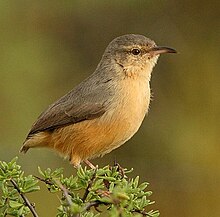Old World warblers are a large group of birds formerly grouped together in the bird family Sylviidae. They are not closely related to the New World warblers. The family held over 400 species in over 70 genera, and were the source of much taxonomic confusion. Two families were split out initially, the cisticolas into Cisticolidae and the kinglets into Regulidae. In the past ten years they have been the subject of much research and many species are now placed into other families, including the Acrocephalidae, Cettiidae, Phylloscopidae, and Megaluridae. In addition some species have been moved into existing families or have not yet had their placement fully resolved. A smaller number of warblers, together with some babblers formerly placed in the family Timaliidae and the parrotbills, are retained in a much smaller family Sylviidae.

Stresemann's bushcrow, also known as the Abyssinian pie, bush crow, Ethiopian bushcrow, or by its generic name Zavattariornis, is a rather starling-like bird, which is a member of the crow family, Corvidae. It is slightly larger than the North American blue jay and is a bluish-grey in overall colour which becomes almost white on the forehead. The throat and chest are creamy-white with the tail and wings a glossy black. The black feathers have a tendency to bleach to brown at their tips. The iris of the bird is brown and the eye is surrounded by a band of naked bright blue skin. The bill, legs, and feet are black.

The black-billed wood dove is a pigeon which is a widespread resident breeding bird in a belt across Africa just south of the Sahara Desert.

The Drakensberg prinia or saffron-breasted prinia is a small passerine bird. It lives in eastern South Africa and Eswatini.
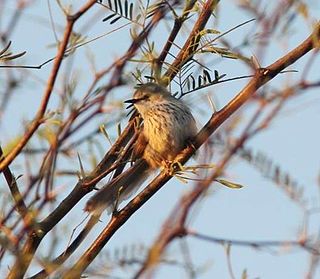
The Namaqua warbler, also known as the Namaqua prinia or white-breasted prinia, is a small passerine bird, a cisticolid warbler and the sole member of the genus Phragmacia. It was formerly placed in the genus Prinia, but was found to be sufficiently distinct to warrant a genus of its own.

The neddicky, or piping cisticola, is a small passerine bird in the family Cisticolidae, which is native to Africa, southwards of the equator. Its strongholds are the light woodlands and shrublands of the subtropics and temperate regions of southern Africa. The common name, neddicky, is the Afrikaans name for the species.
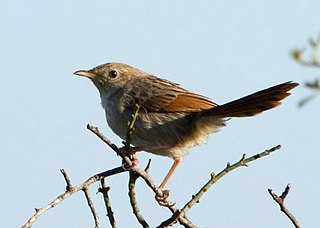
The grey-backed cisticola or red-headed cisticola is a small passerine bird. This cisticola is a resident breeder in southernmost Angola, Namibia and western South Africa.

Levaillant's cisticola, also known as the tinkling cisticola, is a small passerine bird which is native to marshlands in the uplands of Africa, southwards of the equator.
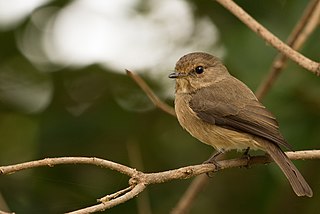
The African dusky flycatcher, also known as the dusky-brown flycatcher or dusky alseonax, is a small passerine bird of the Old World flycatcher family, Muscicapidae. It is a resident breeder in Africa from Nigeria, the Central African Republic, South Sudan and Ethiopia south to South Africa. It is very common in its woodland habitat, which includes riverine forests, evergreen forest edges and clearings, especially near water bodies such as lakes, dams and streams, and well-wooded suburban gardens.

The lesser swamp warbler or Cape reed warbler is an Old World warbler in the genus Acrocephalus. It is a resident breeder in Africa from the Democratic Republic of the Congo, the Chad and Ethiopia south to South Africa. This is a common species of reedbeds in standing water.

The Cape grassbird or Cape grass warbler is an African warbler found in southern Africa. It is the only species placed in the genus Sphenoeacus.
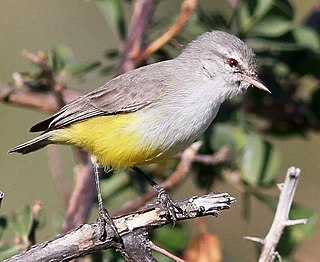
The yellow-bellied eremomela is an Old World warbler. However, the taxonomy of the "African warblers", an assemblage of usually species-poor and apparently rather ancient "odd warblers" from Africa is currently in a state of flux. Today, most taxonomists consider members in this genus members of the family Cisticolidae.

Sylvietta, the crombecs, is a genus of African warblers. Formerly placed in the massively paraphyletic family Sylviidae, it is now considered to belong to a newly recognized family found only in Africa, Macrosphenidae.

The red-faced crombec is a species of African warbler, formerly placed in the family Sylviidae. It is found in Burundi, Ethiopia, Kenya, Malawi, Mozambique, Namibia, Rwanda, South Sudan, Tanzania, Uganda, and Zimbabwe. Its natural habitats are subtropical or tropical dry forests, subtropical or tropical moist montane forests, and subtropical or tropical dry shrubland.

The Taita fiscal or Teita fiscal is a member of the shrike family found in east Africa from southeastern South Sudan, southern Ethiopia, and western Somalia to northeastern Tanzania. Its habitat is dry open thornbush and acacia and other dry open woodland.

The African cuckoo is a species of cuckoo in the family Cuculidae. It is found in Sub-Saharan Africa where it migrates within the continent, generally arriving and breeding in any one locality during the rainy season. A fairly common bird, the International Union for Conservation of Nature has rated its conservation status as being of "least concern".
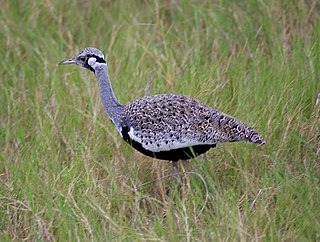
Hartlaub's bustard is a species of bird in the family Otididae. It is found in open grassland with grass up to 1800 meters in Ethiopia, Kenya, Somalia, Sudan, Tanzania, and Uganda.

The grey-capped social weaver is a sparrow-like liver-colored bird, with a pale grey crown, a dark grey bill, a whitish eye-ring, horn-colored legs, with some black in the wing and a light terminal band in the tail, that builds roofed nests made of straws, breeds in colonies in thorny Acacia trees, and feeds in groups gathering grass seeds and insects. Male and female have near identical plumage. DNA-analysis confirms it is part of the weaver family. It is found in Ethiopia, Kenya, Somalia, South Sudan, Sudan, Tanzania, and Uganda.

Bennett's woodpecker is a species of bird in the family Picidae. It is found in woodlands and bushes in Africa. The International Union for Conservation of Nature (IUCN) has assessed it as a least-concern species.

The African warblers are a newly erected family Macrosphenidae, of African songbirds. Most of the species were formerly placed in the Old World warbler family Sylviidae, although one species, the rockrunner, was placed in the babbler family, Timaliidae. A series of molecular studies of the Old World warblers and other bird families in the superfamily Sylvioidea found that the African warblers were not part of Sylviidae but were instead an early (basal) offshoot of the entire clade Sylvioidea. Some taxonomic authorities place the entire family Hyliidae here.
